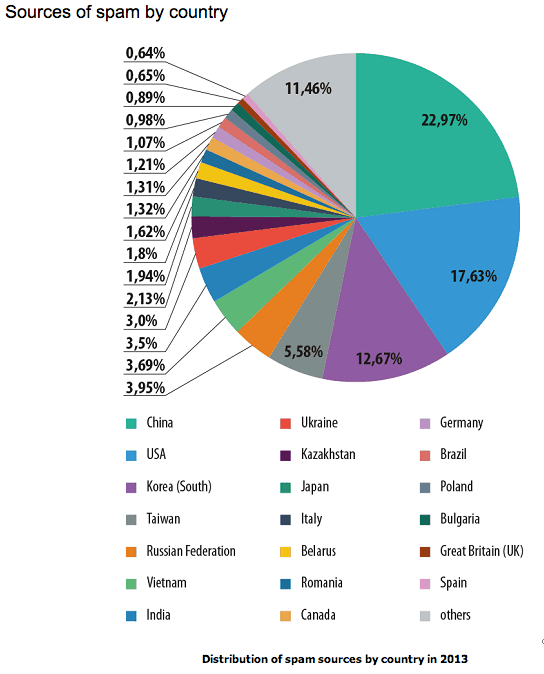With a 1.37 billion population, more than 1.2 billion mobile subscribers and 300 million internet users, China seems to be a firm believer in total world dominance – including the disgraceful achievement of being termed – “Top producer of Spam”. In 2013, China had left the U.S. behind in number of email spams by contributing 22.97% of the world’s total spam. In fact the growth in China’s contribution in the spam market is faster than any other country. Consequently, Asia emerged as the largest producer of spam with 55.53% market in 2013, followed by North America.
According to the new security bulletin, the worldwide spam rate fell to 69.6% in 2013 compared to 72.1% in the previous year. Spammers were apparently more active during Christmas and new year holiday season as spam rate had touched the peak 73.26% in December 2013.
The technology advancement has brought significant changes in the operations of the spammers, as did the best antivirus software on the market. This has resulted in a diverged focus and instead of bank accounts and other financial data, spammers have moved on to social network channels and emails as their favorite illicit playground. The real looking emails, tempting messages that call for an action and travel related information have become the latest tools to trick users. By attaching a super light-weight malware file with such mail or messages, spammers try to create a genuine looking scenario that increases the possibility of acting on such spam by users.
“As we see fewer legal commercial offers in spam, the more we see fraudulent and malicious messages appearing,” the report said. “Previously cybercriminals could rely on exploiting the trust of unwary users, but now they face a new generation of IT-savvy targets. That has prompted them to adopt new tactics, such as sending out malicious attachments in the guises of antivirus updates.”
Variants of Trojan horses are most popular among spammers. The Trojan family collectively ‘powered’ more than 50% of malicious email distribution in 2013. Considering the maximum returns (call it damages) spammers had targeted the U.S., U.K. and Germany for their malware focused emails. Interestingly, the U.K. witnessed a sudden spike in being targeted as its share went up from 5.4% in Q1 2013 to 11.9% in Q4.
Spammers have adopt more ‘legitimate ways’ to trick spam filtration installed on email servers these days. Though, server administrators and users download antivirus to filter such spam, the growing intelligence of spammers is keeping all antivirus software development companies on their toes. Instead of sending bulk emails through fake or free email IDs, spammers have started using effective bulk email software along with emails that belongs to content rich active websites. This helps spam mails to bypass security screening easily and in case of any reports spammers easily find themselves on a safe haven.
The exploding penetration of social networks across the globe has helped spammers target internet users more than ever. Spam attacks also involve phishing attacks, virus downloads and hacking accounts on social media, which have reached 32.1% of the market, followed by 12.46% through emails and IMS.
The report briefly speaks about the future projection of the spam industry. While the number of attacks is expected to remain nearly the same, spammers would adapt new techniques and technology driven processes that could trick more number of users, resulting in higher success ratios.




